Stories: Living with Other Types of Congenital Heart Defects
Congenital heart defects (CHDs) are present at birth and can affect the structure of a baby’s heart and the way it works. They can affect how blood flows through the heart and out to the rest of the body. To learn what it’s like to live with these types of conditions or how families are affected, read these real stories from people living with congenital heart defects.
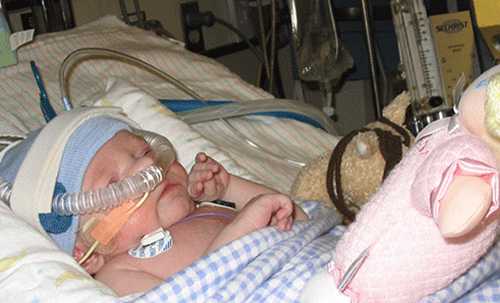
Piper’s Story—Written by her dad, David
David’s daughter, Piper, was diagnosed with a congenital heart defect (CHD) shortly after she was born. Read below about Piper’s first few weeks of life and how David and his family support CHD awareness.
Piper, our first child, was born on Independence Day. I’m very patriotic, so I remember thinking what a great symbol this July 4th baby was going to be. My wife, Jennifer, had a healthy pregnancy with no problems during the delivery. Then, everything changed.
Piper was born blue. The doctor thought she just needed some oxygen, so we relaxed thinking this was a fairly normal situation. However, after two hours passed without seeing or holding our child, we began to wonder if something was really wrong. When the doctor finally returned, he said her oxygen levels were not getting better. He was worried about her heart, but the hospital didn’t have the right equipment to run the tests to check her heart. So, we had to send Piper by ambulance to the major children’s hospital in our state. Along with Piper, I left Jennifer in the early evening on what seemed like the longest ambulance ride in history—not because we were going slow, but because our world was flipped upside-down.
At the children’s hospital, the doctors were able to diagnose Piper with (TGA) and several large ventricular septal defects (VSDs). TGA is a type of heart defect where the two main blood vessels leading out of the heart are switched in position. And VSDs are holes in the wall that separates the lower chambers of the heart. Bottom line, Piper required open heart surgery to live.
In the meantime, Jennifer was still at the first hospital, in absolute shock. Who wouldn’t be? It’s very scary. You’re having a baby, there’s something wrong, and you’re away from your spouse. She was finally able to check herself out and arrived at the children’s hospital in the middle of the night. We slept on the loveseat of the waiting room that first night—the first of what would become a stressful and sleep-deprived several weeks.
At the time, I didn’t think that Piper was going to make it. Her surgery took a grueling 14 hours. Afterwards, Piper’s tiny body began to swell. The doctors needed to open her chest to relieve the swelling. Piper was unrecognizable—attached to what seemed like hundreds of tubes and cords.
We spent several weeks at the hospital. We showered and ate in the hospital every day, worrying constantly. “What are we going to do?” “What does this mean?”
At one point, Piper caught two infections that required her to be in an isolation room for several weeks. We had seen many sick babies go into isolation rooms, and most did not survive. That moment was my breaking point. I tried to stay strong throughout the process and be strong for Jennifer. But at that point, I broke. Two days later, though, our prayers were answered. Piper started to turn around. During this entire time, Jennifer didn’t get to hold Piper. It’s an incredibly tough and heartbreaking situation to live through. But, about six weeks later, Piper had improved enough for us to take her home.
As I started researching about CHDs, I realized that they are chronic, lifelong conditions. It was really difficult to come to grips with that. I had no clue what questions to ask or where to go for information. As my curiosity turned into action, I partnered with another parent of a child with a CHD, and we established an organization devoted to children with CHDs.
There are still a lot of unknowns about CHDs. Every parent has questions about what to expect, who to turn to, and what the future holds. Patients like Piper have a powerful voice, and together, we can greatly increase public awareness of CHDs and those living with these conditions.
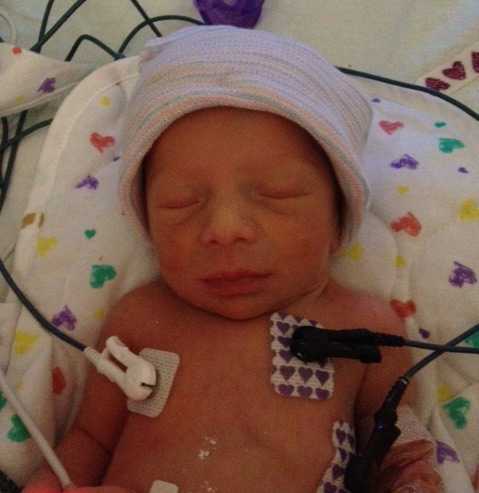
Hannah’s Story—Written by her mom, Leslie
Hannah was born with several critical congenital heart defects. Hannah’s family is forever grateful for the three weeks they were able to spend with her before she passed. Read their special story of Hannah below.
My husband, Nick, and I were ecstatic when we learned that we were pregnant with our first child last February. The excitement grew when we found out that we were having identical twins, but it was short lived. The doctors diagnosed our girls as Monoamniotic-Monochorionic, or “mono mono,” meaning they shared the same sac with no dividing membrane and the same placenta. This type of pregnancy is extremely rare and very high risk, due to cord entanglement issues. We were given a poor prognosis and told that 80 percent of people in our situation would terminate the pregnancy. Nick and I plunged forward, hoping and praying for the best for our babies.
Unfortunately the stress did not end there. At five months of pregnancy one of our girls, Hannah, was diagnosed with heterotaxy syndrome causing several complex congenital heart defects, two of which were known as total anomalous pulmonary venous return (TAPVR) and pulmonary atresia. We began seeing a pediatric cardiologist who informed us that Hannah’s condition was very precarious and would require a series of three open heart surgeries over the course of the first five years of life, the first of which would most likely be performed the day of birth. To complicate matters, Hannah would be premature and underweight, as she and Elizabeth had to be delivered via C-section at 32 weeks gestation in order to increase their chance of survival due to their “mono mono” diagnosis. As a result, I had to spend the last two months of my pregnancy on the bed rest at the hospital for daily fetal monitoring.
Hannah and Elizabeth were born at three pounds nine ounces and three pounds fifteen ounces, respectively. They were immediately whisked away and after hours of echocardiograms, it was determined that it was in Hannah’s best interest to prolong surgery for several weeks in order to let her gain weight and increase the chance of a successful surgery. Nick and I were cautiously optimistic but painfully aware that a favorable outcome was not guaranteed.
Just three weeks later, Hannah underwent open heart surgery. After almost 12 hours of anguished waiting, we were told that the surgery had been a success but that the next 48 to 72 hours were critical. Literally as we were preparing to leave the hospital to go home that same night, Hannah’s heart stopped beating. The doctors were able to revive her and aggressively monitored her condition overnight.
Early the next morning, Hannah passed in our arms. Her surgeon assured us that we had done everything possible to save her but unfortunately her lungs could not support her heart condition. We are saddened beyond belief at our loss, but we believe Hannah is in a better place and we are comforted that she is no longer in pain or suffering. She was a fighter until the end and we will forever be grateful for the three weeks we were able to spend with our little angel.

Isabella’s Story—Written by her mom, Melissa
Isabella was born with a congenital heart defect. When her mother, Melissa, first learned of Isabella’s heart defect during pregnancy, she was devastated. But here Melissa shares how Isabella’s condition has taught her family how to really appreciate what they have and the time they have together. Read more of Isabella’s story below.
Isabella is your typical child with lots of spunk and personality! She loves playing outside with her older brother and playing with her many baby dolls, including listening to their “heart.” She enjoys bubbles, taking baths, and spaghetti!
We first found out our daughter, Isabella, had a congenital heart defect at 19 weeks of pregnancy. We went in for our ultrasound to find out if we were having a boy or a girl, and we were thrilled to find out we were having a girl!
It seems like so long ago, but remembering back to that day, the ultrasound tech hovered over her heart during the ultrasound, and our excitement quickly came to a halt. Our fear was confirmed a few moments later by our OB-GYN, and it felt as if our world was crashing down. Our daughter had a heart defect. Our family had no history of heart defects. Why was this happening to us? We were devastated. Up until this point, I had never heard of infants being born with half a heart. Who could even survive that? We felt defeated, emotionally exhausted, worried, and terrified. We were scared she wouldn’t make it.
The hardest thing I have ever had to do is watch my child go through open heart surgery. Thankfully, Isabella has done very well with her condition. Her condition is very rare and is known as “Holmes Heart” (basically, she has half of a functioning heart). There have been bumps along the way, but with each bump, it has brought us closer together as a family. Being away from my other child multiple times while staying in the hospital is hard, along with the fear that comes with these surgeries. Her brother is several years older than she is, so he has a pretty good understanding but is still scared for her life. He is very protective over her. It has also impacted us financially and emotionally. On a positive note, it has made us reach out to strengthen our Faith. I believe that is the only thing that has gotten us through these past three years. I can truly say we now live our lives to the fullest every day. This experience has taught us how to really appreciate what we have and the time we have together.
I would like other parents facing this unknown world of heart defects to know that there is hope. Many people in the medical profession are making huge strides in regards to treatment for heart defects. Researchers are working on amazing advances to allow these children to live a full and prosperous life. There is support available to help you along this journey. Help spread the word about heart defects and how amazing these kids are! Our daughter, Isabella, is very special and inspires me daily!
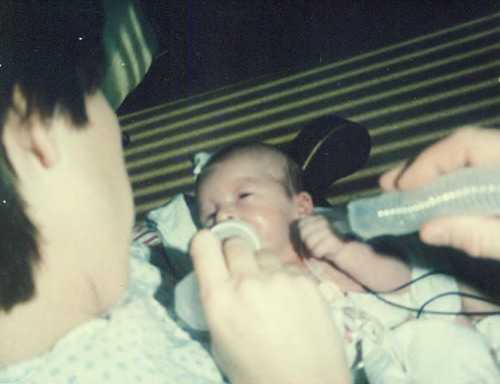
Catherine’s Story—In her own words
Catherine was born with pulmonary atresia, but her heart defect never stopped her from reaching her goals in life. Having a heart defect gives her a platform to inspire and help others who have a similar condition. Read her story below.
When I was born, my parents and doctors knew immediately that something was wrong. I was transferred to the local children’s hospital and after several procedures, I was diagnosed with pulmonary atresia, a type of congenital heart defect (CHD). I had three open heart surgeries in the first 18 months of my life. I even spent my first Christmas in the children’s hospital. These first surgeries were not easy. I had complications with each one. However, the wonderful care that I received carried me through those difficult times.
Growing up, my parents never allowed my heart condition to get in the way of me doing any activity. I have an identical twin sister who doesn’t have a CHD, and they treated us just the same. I played competitive soccer and attended some of the nation’s best tournaments. Every year, I had a check-up with my cardiologist, and my mom would make it a fun day away from school. I stayed with my pediatric cardiologist until I was 21 years old.
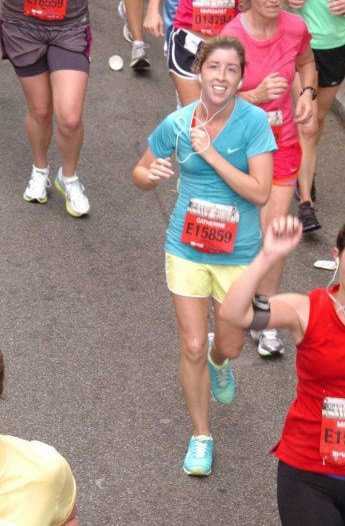
I was able to attend my dream college and was also a recipient of a scholarship specifically for students with a CHD. Since graduating college, I am now a special education teacher and I have served on many committees that foster mentor relationships between those with special needs and other students. I also present at conferences related to special education.
During the winter of 2012, I learned that my pulmonary valve would have to be replaced. During that time, I was able to get in the best shape of my life, and I ran a 10-kilometer race just two months before my surgery. In June of 2012, I had my fourth open heart surgery, where I was given a bovine pulmonary valve. Since that surgery, I have fully recovered and today I continue my passion of teaching students with special needs.
I graduated with my master’s degree in mild and moderate intellectual disabilities. I also married my husband, Max. I know that having a CHD gives me a wonderful platform to help others with the same condition. I look forward to more opportunities where I can continue to help and inspire others.

Missy’s Story—In her own words
Ongoing, appropriate medical care can help children and adults with a congenital heart defect (CHD) live as healthy as possible. Missy was born with a CHD. Read below to learn how her commitment to lifelong care for her CHD has helped her live a healthy life.
My name is Missy, and I’m a congenital heart defect (CHD) survivor. I was born with aortic stenosis, bicuspid valve. This means that my aortic valve, the heart valve that controls blood flow from my heart to my aorta, was narrow and only had two flaps, instead of the normal three flaps. This condition affected the way blood flowed out from my heart to the rest of my body.
Although my mother knew I had a CHD since I was a baby, I was not aware that I had any heart condition until 6th grade when I was participating in physical education class. I suddenly got dizzy and almost passed out. It was then that my cardiac care began. My first procedure was having a heart catheter put in place to help with the blood flow through my heart. Shortly after I turned 12-years-old, I had open heart surgery to repair my aortic valve. Throughout the rest of my adolescence, I had regular checkups with my cardiologist (my heart doctor).
When I was nearly 20-years-old, I had my second open heart surgery—this time, it was to replace my aortic valve. I was given the option of a pig valve or a human valve from a cadaver, which was a new procedure in the late 1980’s. The latest research had indicated that the human valve would hold up better during pregnancies and potentially last longer than the pig valve option. Therefore, I chose to have the human valve replacement. The surgery went well. Shortly afterwards, I began a career that I loved and met my husband. I had two healthy pregnancies resulting in two healthy children.
When my youngest was 3-years-old, I had my third open heart surgery to replace the aortic valve again. This time, a mechanical valve was placed in my heart. Again, I did well with this procedure. I had to start taking some medication to help me, but overall, I led a normal, healthy life, and I felt good.
Then, on one of my annual cardiac checkups, my doctor found I had so much scar tissue buildup in my mechanical valve that it was not working. I had no symptoms. I was only diagnosed because I kept my annual visit to see my cardiologist. Shortly afterwards, I had my 4th and hopefully final surgery to replace that valve again.
My experience underscores the importance of continued care for all CHD patients. CHDs are never permanently fixed. Continued follow up care is critical.
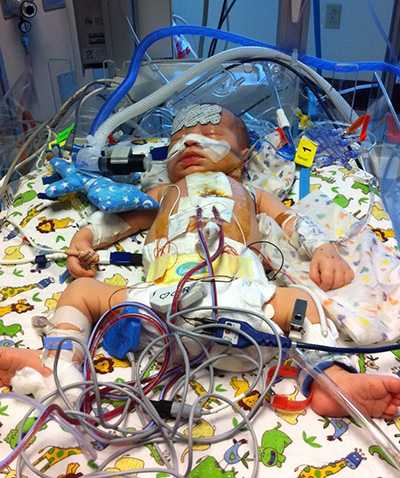
Jefferson’s Story—Written by his dad, Joseph
Jefferson was born with a congenital heart defect called . His father, Joseph, recounts the story of Jefferson’s birth and early care. Read this story and Joseph’s advice for other dads below.
My son, Jefferson, was born blue. We didn’t know ahead of time that he had a heart defect, so we were quite surprised during delivery. As the medical team attended to him, I remember them saying, “there’s nothing we can do.” My stomach dropped. Then, they quickly decided he needed to be rushed to the local children’s hospital. It was quite a whirlwind. I had to leave my wife at the original hospital and go with my son to the children’s hospital, where doctors discovered he had a congenital heart defect called “transposition of the great arteries”. This means that his main arteries (aorta and pulmonary) leading out of his heart were switched, and he would need open-heart surgery to repair them.
Looking back, I think one of the hardest things I had to do at the time was to leave my wife at the hospital. She had some complications from delivery and had to stay there for a little while longer. Unfortunately, it was hard to even get updates on my wife’s condition, because I had bad cell phone reception where I was waiting at the children’s hospital. Honestly, I felt really guilty for not being able to support my wife during this time. I’m grateful her sister was there to stay with her and comfort her. Eventually I came to realize that the best way to be there for my wife was to be there for our son. I didn’t leave Jefferson’s side for the first five days of his life, and I think that helped give her some peace of mind.
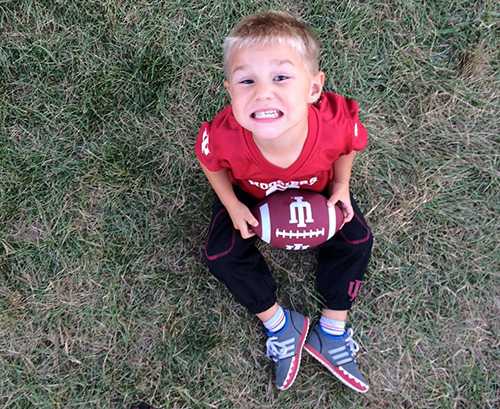
Another challenge for me was having to relay everything the doctors were telling me about Jefferson’s condition back to my wife. I was a college football coach. I didn’t speak the medical language. At times, I didn’t always feel valued as the father, because the medical team always wanted to speak to the mother. If I could give advice to other dads who are in the same position, I would say to be persistent. Keep asking questions, especially when you feel like you aren’t getting all the information. Another bit of advice is to take care of yourself. Remember to eat. Remember to sleep. You need to be at your best to be the best for your child.
Jefferson had one open-heart surgery four weeks after he was born, and he’s been doing well ever since. He’s such a light in our lives. He’s positive, always smiling, and just lights up a room.
- Page last reviewed: June 27, 2017
- Page last updated: June 27, 2017
- Content source:


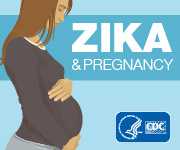
 ShareCompartir
ShareCompartir